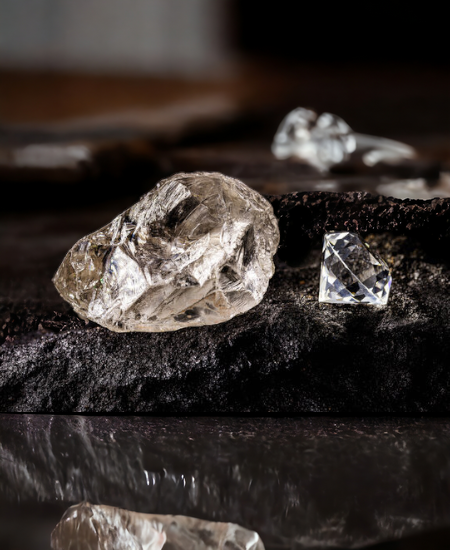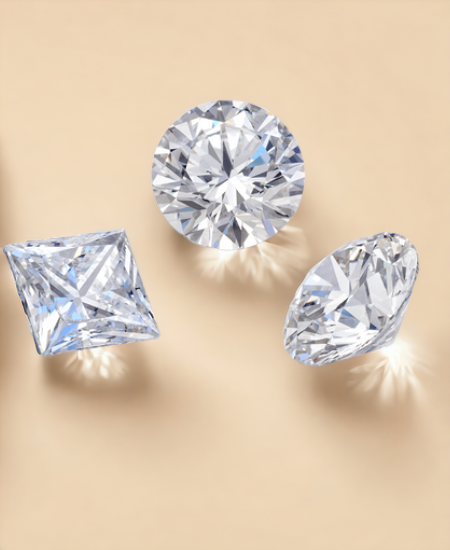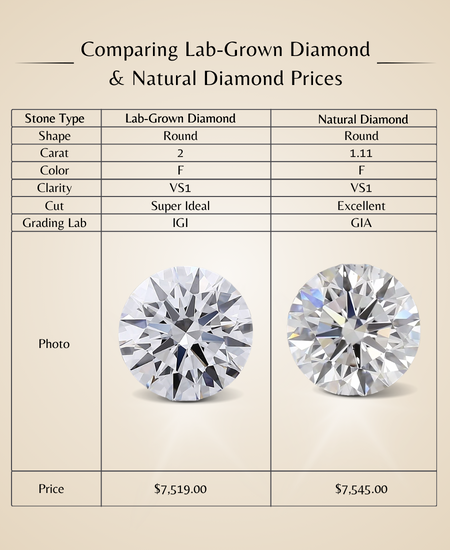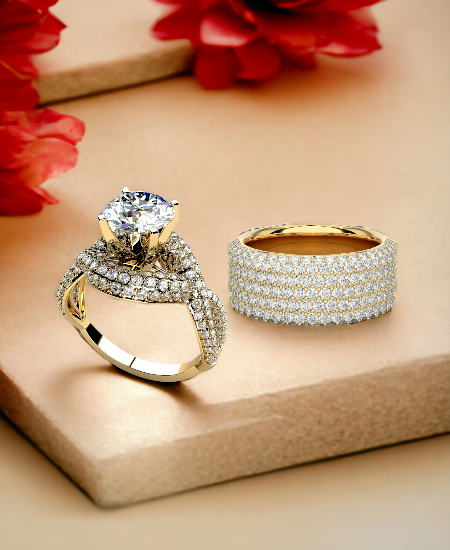Are you curious about the differences between lab-grown and natural diamonds? Well, you've come to the right place. In this blog post, we'll be diving into the world of diamonds and exploring the pros and cons of each type. With advancements in technology, lab-grown diamonds have become a popular alternative to natural diamonds. But what sets them apart? Join us as we uncover the truth about lab-grown vs. natural diamonds and help you make an informed decision for your next diamond purchase.
THE FORMATION PROCESS OF NATURAL DIAMONDS
 Natural diamonds are formed deep within the Earth's mantle under intense pressure and heat. It all begins with carbon atoms, which are found in abundance within the Earth's crust. Over millions of years, these carbon atoms have been subjected to immense pressure, often caused by tectonic plate movement, and extreme temperatures of over 2,200 degrees Fahrenheit. Under these extreme conditions, the carbon atoms bond together in a crystalline structure, forming diamonds.
Natural diamonds are formed deep within the Earth's mantle under intense pressure and heat. It all begins with carbon atoms, which are found in abundance within the Earth's crust. Over millions of years, these carbon atoms have been subjected to immense pressure, often caused by tectonic plate movement, and extreme temperatures of over 2,200 degrees Fahrenheit. Under these extreme conditions, the carbon atoms bond together in a crystalline structure, forming diamonds.
The diamonds then slowly make their way towards the Earth's surface through volcanic eruptions. These eruptions, called kimberlite eruptions, carry the diamonds to the surface, where they are eventually discovered. The formation process of natural diamonds is a rare and remarkable phenomenon that takes millions of years to occur. Each diamond is unique, with its distinct characteristics, including color, clarity, and cut.
THE CREATION OF LAB-GROWN DIAMONDS
 Lab-grown diamonds, also known as man-made or lab-created diamonds are created in a laboratory instead of being formed naturally in the Earth's crust. The process of creating lab-grown diamonds involves using advanced technology to replicate the same conditions that occur deep within the Earth.
Lab-grown diamonds, also known as man-made or lab-created diamonds are created in a laboratory instead of being formed naturally in the Earth's crust. The process of creating lab-grown diamonds involves using advanced technology to replicate the same conditions that occur deep within the Earth.
To start, a tiny diamond seed is placed in a growth chamber, which is then filled with a mixture of carbon and other elements. Through a combination of extreme heat and pressure, the carbon atoms begin to bond together and form a crystalline structure, just like natural diamonds. This process takes several weeks to months, depending on the desired size of the diamond. The result is a lab-grown diamond that is chemically and physically identical to a natural diamond. They have the same hardness, brilliance, and durability. However, some differences can be detected by trained gemologists.
THE PRICING DIFFERENCE
 When it comes to buying a diamond, one of the key factors that many people consider is the price. The pricing difference between lab-grown and natural diamonds can be significant. Usually, diamonds made in a lab cost less than natural diamonds. This is because the process of creating lab-grown diamonds in a controlled environment is more cost-effective than mining and extracting natural diamonds from the Earth. The affordability of lab-grown diamonds is one of the main advantages they have over natural diamonds. For those who are looking for a beautiful diamond at a more affordable price, lab-grown diamonds are a great option. They offer the same quality and characteristics as natural diamonds but without the hefty price tag.
When it comes to buying a diamond, one of the key factors that many people consider is the price. The pricing difference between lab-grown and natural diamonds can be significant. Usually, diamonds made in a lab cost less than natural diamonds. This is because the process of creating lab-grown diamonds in a controlled environment is more cost-effective than mining and extracting natural diamonds from the Earth. The affordability of lab-grown diamonds is one of the main advantages they have over natural diamonds. For those who are looking for a beautiful diamond at a more affordable price, lab-grown diamonds are a great option. They offer the same quality and characteristics as natural diamonds but without the hefty price tag.
On the other hand, natural diamonds are generally more expensive due to their rarity and the labor-intensive process involved in mining them. The supply of natural diamonds is limited, which drives up their price. Additionally, the mining process can be environmentally and ethically concerning, contributing to the higher cost of natural diamonds. Ultimately, the pricing difference between lab-grown and natural diamonds allows consumers to choose based on their budget and priorities.
THE ENVIRONMENTAL AND ETHICAL FACTORS
When it comes to diamonds, the environmental and ethical factors play a significant role in decision-making. Natural diamond mining can have a detrimental impact on the environment. The process involves clearing land, displacing wildlife, and releasing harmful chemicals into the air and water. Additionally, the diamond industry has faced scrutiny for its labor practices, including reports of forced labor and poor working conditions in some mining areas.
On the other hand, lab-grown diamonds offer a more sustainable and ethical alternative. Since they are created in a controlled laboratory environment, there is no need for mining or land disruption. Lab-grown diamonds also have a smaller carbon footprint compared to their natural counterparts, as they require less energy and water to produce.
In terms of ethics, lab-grown diamonds are considered conflict-free. Natural diamonds, on the other hand, have a history of being associated with conflict or "blood diamonds," which are mined in war zones and used to fund armed conflicts. It's crucial to make an informed decision and choose a diamond that aligns with your values.
DECIDING WHICH DIAMOND IS BEST FOR YOU
 Deciding which diamond is best for you can be a challenging decision, but it ultimately comes down to your personal preferences and priorities. If you value the natural beauty and uniqueness that comes with a natural diamond, then it may be the right choice for you. Natural diamonds have a timeless appeal and a long history of being treasured as precious gems. They often have a higher market value and are considered a symbol of luxury and prestige.
Deciding which diamond is best for you can be a challenging decision, but it ultimately comes down to your personal preferences and priorities. If you value the natural beauty and uniqueness that comes with a natural diamond, then it may be the right choice for you. Natural diamonds have a timeless appeal and a long history of being treasured as precious gems. They often have a higher market value and are considered a symbol of luxury and prestige.
On the other hand, if you prioritize sustainability, ethical sourcing, and a smaller environmental footprint, then a lab-grown diamond might be the better option. Lab-grown diamonds offer the same physical and chemical properties as natural diamonds but without the ethical concerns associated with mining. They are created in a controlled environment using advanced technology, making them a more eco-friendly choice.
Consider your budget as well. Natural diamonds tend to be more expensive due to their rarity, while lab-grown diamonds can offer a more affordable alternative without sacrificing quality.
In the end, choosing between natural and lab-made diamonds depends on what's important to you. Spend some time learning about each type, compare them, and decide what you like the most. No matter if you pick a real or lab-made diamond, the key is to find one that suits your beliefs and makes you feel good.
Comments (0)